This information re perfumes was sourced from a Wikipedia page at the following address: http://en.wikipedia.org/wiki/Perfume
PERFUMES
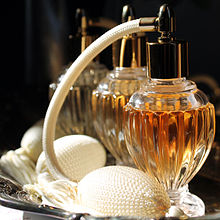
Vintage atomizer perfume bottle
Perfume or parfum is a mixture of fragrant essential oils or aroma compounds, fixatives and solvents used to give the human body, animals, food, objects, and living spaces "a pleasant scent."
Perfumes have been known to exist in some of the earliest human civilizations, either through ancient texts or from archaeological digs. Modern perfumery began in the late 19th century with the commercial synthesis of aroma compounds such as vanillin or coumarin, which allowed for the composition of perfumes with smells previously unattainable solely from natural aromatics alone.
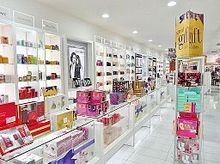
Fine Fragrance counter at department store Farmers Te Awa at The Base in Hamilton, New Zealand
HISTORY
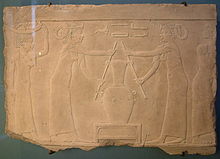
Egyptian scene depicting the preparation of Lily perfume, 4th century BC
The word perfume derives from the Latin perfumare, meaning "to smoke through." Perfumery, or the art of making perfumes, began in ancient Mesopotamia and Egypt, and was further refined by the Romans and Persians.
The world's first-recorded chemist is considered to be a woman named Tapputi, a perfume maker who was mentioned in a cuneiform tablet from the 2nd millennium BC in Mesopotamia. She distilled flowers, oil, and calamus with other aromatics, then filtered and put them back in the still several times. In India, perfume and perfumery also existed in Indus civilization (3300 BCE - 1300 BCE). One of the earliest distillation of Ittar was mentioned in the Hindu Ayurvedic text Charaka Samhita and Sushruta Samhita.
In 2004 - 2005, archaeologists uncovered what are believed to be the world's oldest perfumes in Pyrgos, Cyprus. The perfumes date back more than 4,000 years. They were discovered in an ancient perfumery, a 4,000-square-metre (43,000 sq ft) factory housing at least 60 stills, mixing bowls, funnels, and perfume bottles. In ancient times people used herbs and spices, such as almond, coriander, myrtle, conifer resin, and bergamot, as well as flowers.
The Arab chemist Al-Kindi (Alkindus) wrote the Book of the Chemistry of Perfume and Distillations in the 9th century, which contained more than a hundred recipes for fragrant oils, salves, aromatic waters, and substitutes or imitations of costly drugs. The book also described 107 methods and recipes for perfume-making and perfume-making equipment, such as the alembic (which still bears its Arabic name described by Synesius in the 4th century).
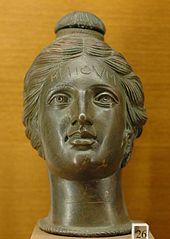
Etruscan perfume vase shaped like a female head, 2nd century BC
The Persian chemist Ibn Sina (also known as Avicenna) introduced the process of extracting oils from flowers by means of distillation, the procedure most commonly used today. He first experimented with the rose. Until his discovery, liquid perfumes were mixtures of oil and crushed herbs or petals, which made a strong blend. Rose water was more delicate, and immediately became popular. Both the raw ingredients and the distillation technology significantly influenced western perfumery and scientific developments, particularly chemistry.
The art of perfumery was known in Western Europe ever since 1221, taking into account the monks' recipes of Santa Maria delle Vigne or Santa Maria Novella of Florence, Italy. In the east, the Hungarians produced in 1370 a perfume made of scented oils blended in an alcohol solution at the command of Queen Elizabeth of Hungary, best known as Hungary Water. The art of perfumery prospered in Renaissance Italy, and in the 16th century, Italian refinements were taken to France by Catherine de' Medici's personal perfumer, Rene the Florentine (Renato il fiorentino). His laboratory was connected with her apartments by a secret passageway, so that no formulae could be stolen en route. Thanks to Rene, France quickly became one of the European centres of perfume and cosmetics manufacture. Cultivation of flowers for their perfume essence, which had begun in the 14th century, grew into a major industry in the south of France.
Between the 16th and 17th century, perfumes were used primarily by the wealthy to mask body odours resulting from infrequent bathing. Partly due to this patronage, the perfume industry was created. In Germany, Italian barber Giovanni Paolo Feminis created a perfume water called Aqua Admirabilis, today best known as eau de cologne, while his nephew Johann Maria Farina (Giovanni Maria Farina) in 1732 took over the business.
By the 18th century, aromatic plants were being grown in the Grasse region of France, in Sicily, and in Calabria, Italy, to provide the growing perfume industry with raw materials. Even today, Italy and France remain the centre of the European perfume design and trade.
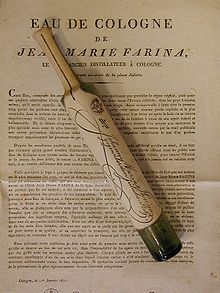
Original Eau de Cologne flacon 1811, from Johann Maria Farina, Farina gegenüber
CONCENTRATION
Perfume types reflect the concentration of aromatic compounds in a solvent, which in fine fragrance is typically ethanol or a mix of water and ethanol. Various sources differ considerably in the definitions of perfume types. The intensity and longevity of a perfume is based on the concentration, intensity and longevity of the aromatic compounds (natural essential oils / perfume oils) used: As the percentage of aromatic compounds increases, so does the intensity and longevity of the scent created. Specific terms are used to describe a fragrance's approximate concentration by percent/volume of perfume oil, which are typically vague or imprecise. A list of common terms (Perfume-Classification) is as follows:
- Perfume extract, or simply perfume (extrait): 15–40% (IFRA: typical 20%) aromatic compounds
- Esprit de Parfum (ESdP): 15–30% aromatic compounds, a seldom used strength concentration in between EdP and perfume
- Eau de Parfum (EdP), Parfum de Toilette (PdT): 10–20% (typical ~15%) aromatic compounds, sometimes listed as "eau de perfume" or "millésime." Parfum de Toilette is a less common term that is generally analogous to Eau de Parfum.
- Eau de toilette (EdT): 5–15% (typical ~10%) aromatic compounds
- Eau de Cologne (EdC): Chypre citrus type perfumes with 3–8% (typical ~5%) aromatic compounds. "Original Eau de Cologne" is a registered trademark.
- Perfume mist: 3–8% aromatic compounds (typical non-alcohol solvent)
- Splash (EdS) and aftershave: 1–3% aromatic compounds. "EdS" is a registered trademark.
A "Classical cologne" describes men's and women's fragrances "which are basically citrus blends and do not have a perfume parent". Classical colognes are different from modern colognes, where the fragrance is typically a lighter, less concentrated interpretation of a perfume. Men's colognes are also different from women's colognes. Men's colognes have a similar concentration to eau de toilette, eau de parfum, "and in some instances perfume"; women's colognes, on the other hand, are often the lightest concentration from a line of women's fragrance products.

Kenzo

Coco Mademoiselle from Chanel

Tresor from Lancome
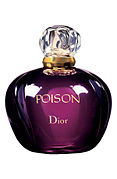
Poison from Dior
Solvent types
Perfume oils are often diluted with a solvent, though this is not always the case, and its necessity is disputed. By far the most common solvent for perfume oil dilution is ethanol like brandy, cognac, pisco, rakia and rectified strips or a mixture of ethanol and water. Perfume oil can also be diluted by means of neutral-smelling oils such as fractionated coconut oil, or liquid waxes such as jojoba oil.

J.B. Filz in Vienna. Perfumeries with long traditions, such as J.B. Filz, created their own scents
Imprecise terminology
J.B. Filz in Vienna. Perfumeries with long traditions, such as J.B. Filz, created their own scents.
Although quite often Eau de Parfum (EdP) will be more concentrated than Eau de Toilette (EdT) and in turn Eau de Cologne (EdC), this is not always the case. Different perfumeries or perfume houses assign different amounts of oils to each of their perfumes. Therefore, although the oil concentration of a perfume in EdP dilution will necessarily be higher than the same perfume in EdT from within the same range, the actual amounts can vary between perfume houses. An EdT from one house may be stronger than an EdP from another.
Men's fragrances are rarely sold as EdP or perfume extracts; equally so, women's fragrances are rarely sold in EdC concentrations. Although this gender-specific naming trend is common for assigning fragrance concentrations, it does not directly have anything to do with whether a fragrance was intended for men or women. Furthermore, some fragrances with the same product name but having a different concentration name may not only differ in their dilutions, but actually use different perfume oil mixtures altogether. For instance, in order to make the EdT version of a fragrance brighter and fresher than its EdP, the EdT oil may be "tweaked" to contain slightly more top notes or fewer base notes. Chanel No. 5 is a good example: its parfum, EdP, and EdT concentrations are in fact different compositions (the parfum dates to 1921, whereas the EdP was not developed until the 1980s). In some cases, words such as extrême, intense, or concentrée that might indicate aromatic concentration are actually completely different fragrances, related only because of a similar perfume accord. An example of this is Chanel's Pour Monsieur and Pour Monsieur Concentrée.
Eau de Cologne (EdC) since 1706 in Cologne, Germany, is originally a specific fragrance and trademark. However outside of Germany the term has become generic for Chypre citrus perfumes (without base-notes). EdS (since 1993) is a new perfume class and a registered trademark.
Applying fragrances
The conventional application of pure perfume (parfum extrait) in Western cultures is at pulse points, such as behind the ears, the nape of the neck, and the insides of wrists, elbows and knees, so that the pulse point will warm the perfume and release fragrance continuously. The modern perfume industry encourages the practice of layering fragrance so that it is released in different intensities depending upon the time of the day. Lightly scented products such as bath oil, shower gel, and body lotion are recommended for the morning; eau de toilette is suggested for the afternoon; and perfume applied to the pulse points for evening. Cologne fragrance is released rapidly, lasting around 2 hours. Eau de toilette lasts from 2 to 4 hours, while perfume may last up to six hours.
A variety of factors can influence how fragrance interacts with the wearer's own physiology and affect the perception of the fragrance. Diet is one factor, as eating spicy and fatty foods can increase the intensity of a fragrance. The use of medications can also impact the character of a fragrance. The relative dryness of the wearer's skin is important, since dry skin will not hold fragrance as long as skin with more oil.
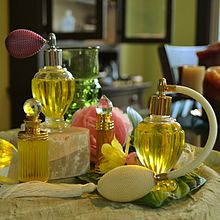
Perfumes. A closed cabinet, to keep out note-destroying sunlight, would be more appropriate
DESCRIBING A PERFUME

Fragrance pyramid
The precise formulae of commercial perfumes are kept secret. Even if they were widely published, they would be dominated by such complex ingredients and odorants that they would be of little use in providing a guide to the general consumer in description of the experience of a scent. Nonetheless, connoisseurs of perfume can become extremely skillful at identifying components and origins of scents in the same manner as wine experts.
The most practical way to start describing a perfume is according to the elements of the fragrance notes of the scent or the "family" it belongs to, all of which affect the overall impression of a perfume from first application to the last lingering hint of scent.
Fragrance notes
Perfume is described in a musical metaphor as having three sets of notes, making the harmonious scent accord. The notes unfold over time, with the immediate impression of the top note leading to the deeper middle notes, and the base notes gradually appearing as the final stage. These notes are created carefully with knowledge of the evaporation process of the perfume.
- Top notes: The scents that are perceived immediately on application of a perfume. Top notes consist of small, light molecules that evaporate quickly. They form a person's initial impression of a perfume and thus are very important in the selling of a perfume. Also called the head notes.
- Middle notes: The scent of a perfume that emerges just prior to the dissipation of the top note. The middle note compounds form the "heart" or main body of a perfume and act to mask the often unpleasant initial impression of base notes, which become more pleasant with time. They are also called the heart notes.
- Base notes: The scent of a perfume that appears close to the departure of the middle notes. The base and middle notes together are the main theme of a perfume. Base notes bring depth and solidity to a perfume. Compounds of this class of scents are typically rich and "deep" and are usually not perceived until 30 minutes after application.
The scents in the top and middle notes are influenced by the base notes, as well the scents of the base notes will be altered by the type of fragrance materials used as middle notes. Manufacturers of perfumes usually publish perfume notes and typically they present it as fragrance pyramid, with the components listed in imaginative and abstract terms.
Olfactive families
Grouping perfumes, like any taxonomy, can never be a completely objective or final process. Many fragrances contain aspects of different families. Even a perfume designated as "single flower", however subtle, will have undertones of other aromatics. "True" unitary scents can rarely be found in perfumes as it requires the perfume to exist only as a singular aromatic material.
Classification by olfactive family is a starting point for a description of a perfume, but it cannot by itself denote the specific characteristic of that perfume.
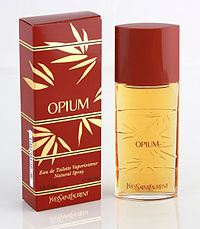
Opium by YSL, of amber or oriental fragrance class
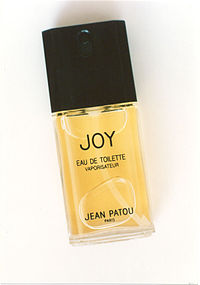
A floral bouquet, Joy from Jean Patou
Traditional
The traditional classification which emerged around 1900 comprised the following categories:
- Single Floral: Fragrances that are dominated by a scent from one particular flower; in French called a soliflore. (e.g., Serge Lutens' Sa Majeste La Rose, which is dominated by rose.)
- Floral Bouquet: Is a combination of fragrance of several flowers in a perfume compound. Examples include Quelques Fleurs by Houbigant and Joy by Jean Patou.
- Amber or "Oriental": A large fragrance class featuring the sweet slightly animalic scents of ambergris or labdanum, often combined with vanilla, tonka bean, flowers and woods. Can be enhanced by camphorous oils and incense resins, which bring to mind Victorian era imagery of the Middle East and Far East. Traditional examples include Guerlain's Shalimar, Yves Saint Laurent's Opium and Chanel's Coco Mademoiselle.
- Woody: Fragrances that are dominated by woody scents, typically of agarwood, sandalwood, cedarwood, and vetiver. Patchouli, with its camphoraceous smell, is commonly found in these perfumes. A traditional example here would be Myrurgia's Maderas De Oriente or Chanel Bois des Îles. A modern example would be Balenciaga Rumba.
- Leather: A family of fragrances which features the scents of honey, tobacco, wood and wood tars in its middle or base notes and a scent that alludes to leather. Traditional examples include Robert Piguet's Bandit and Balmain's Jolie Madame.
- Chypre: Meaning Cyprus in French, this includes fragrances built on a similar accord consisting of bergamot, oakmoss, and labdanum. This family of fragrances is named after the eponymous 1917 perfume by François Coty, and one of the most famous extant examples is Guerlain's Mitsouko.
- Fougère: Meaning Fern in French, built on a base of lavender, coumarin and oakmoss. Houbigant's Fougère Royale pioneered the use of this base. Many men's fragrances belong to this family of fragrances, which is characterized by its sharp herbaceous and woody scent. Some well-known modern fougères are Fabergé Brut and Guy Laroche Drakkar Noir.
Modern
Since 1945, due to great advances in the technology of perfume creation (i.e., compound design and synthesis) as well as the natural development of styles and tastes, new categories have emerged to describe modern scents:
- Bright Floral: combining the traditional Single Floral & Floral Bouquet categories. A good example would be Estée Lauder's Beautiful.
- Green: a lighter and more modern interpretation of the Chypre type, with pronounced cut grass, crushed green leaf and cucumber-like scents. Examples include Estée Lauder's Aliage, Sisley's Eau de Campagne, and Calvin Klein's Eternity.
- Aquatic, Oceanic, or Ozonic: the newest category in perfume history, first appearing in 1988 Davidoff Cool Water (1988), Christian Dior's Dune (1991), and many others. A clean smell reminiscent of the ocean, leading to many of the modern androgynous perfumes. Generally contains calone, a synthetic scent discovered in 1966, or other more recent synthetics. Also used to accent floral, oriental, and woody fragrances.
- Citrus: An old fragrance family that until recently consisted mainly of "freshening" eau de colognes, due to the low tenacity of citrus scents. Development of newer fragrance compounds has allowed for the creation of primarily citrus fragrances. A good example here would be Faberge Brut.
- Fruity: featuring the aromas of fruits other than citrus, such as peach, cassis (black currant), mango, passion fruit, and others. A modern example here would be Ginestet Botrytis.
- Gourmand scents with "edible" or "dessert"-like qualities. These often contain notes like vanilla, tonka bean and coumarin, as well as synthetic components designed to resemble food flavors. A sweet example is Thierry Mugler's Angel.
Fragrance wheel

Fragrance Wheel perfume classification chart, ver. 1983
The Fragrance wheel is a relatively new classification method that is widely used in retail and in the fragrance industry. The method was created in 1983 by Michael Edwards, a consultant in the perfume industry, who designed his own scheme of fragrance classification. The new scheme was created in order to simplify fragrance classification and naming scheme, as well as to show the relationships between each of the individual classes.
The five standard families consist of Floral, Oriental, Woody, Fougère, and Fresh, with the first four families being more "classic" and the last consisting of newer bright and clean smelling citrus and oceanic fragrances that have arrived due to improvements in fragrance technology. Each of the families are in turn divided into sub-groups and arranged around a wheel. In this classification scheme, Chanel No.5, which is traditionally classified as a "Floral Aldehyde" would be located under Soft Floral sub-group, and "Amber" scents would be placed within the Oriental group. As a class, Chypres is more difficult to place since they would be located under parts of the Oriental and Woody families. For instance, Guerlain Mitsouko, which is classically identified as a chypre will be placed under Mossy Woods, but Hermès Rouge, a chypre with more floral character, would be placed under Floral Oriental.
AROMATICS SOURCES
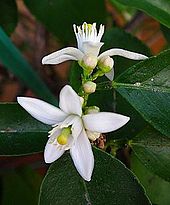
Citrus tree blossom
Plant sources
Plants have long been used in perfumery as a source of essential oils and aroma compounds. These aromatics are usually secondary metabolites produced by plants as protection against herbivores, infections, as well as to attract pollinators. Plants are by far the largest source of fragrant compounds used in perfumery. The sources of these compounds may be derived from various parts of a plant. A plant can offer more than one source of aromatics, for instance the aerial portions and seeds of coriander have remarkably different odours from each other. Orange leaves, blossoms, and fruit zest are the respective sources of petitgrain, neroli, and orange oils.
- Bark: Commonly used barks include cinnamon and cascarilla. The fragrant oil in sassafras root bark is also used either directly or purified for its main constituent, safrole, which is used in the synthesis of other fragrant compounds.
- Flowers and blossoms: Undoubtedly the largest and most common source of perfume aromatics. Includes the flowers of several species of rose and jasmine, as well as osmanthus, plumeria, mimosa, tuberose, narcissus, scented geranium, cassie, ambrette as well as the blossoms of citrus and ylang-ylang trees. Although not traditionally thought of as a flower, the unopened flower buds of the clove are also commonly used. Most orchid flowers are not commercially used to produce essential oils or absolutes, except in the case of vanilla, an orchid, which must be pollinated first and made into seed pods before use in perfumery.
- Fruits: Fresh fruits such as apples, strawberries, cherries rarely yield the expected odours when extracted; if such fragrance notes are found in a perfume, they are more likely to be of synthetic origin. Notable exceptions include blackcurrant leaf, litsea cubeba, vanilla, and juniper berry. The most commonly used fruits yield their aromatics from the rind; they include citrus such as oranges, lemons, and limes. Although grapefruit rind is still used for aromatics, more and more commercially used grapefruit aromatics are artificially synthesized since the natural aromatic contains sulphur and its degradation product is quite unpleasant in smell.
- Leaves and twigs: Commonly used for perfumery are lavender leaf, patchouli, sage, violets, rosemary, and citrus leaves. Sometimes leaves are valued for the "green" smell they bring to perfumes, examples of this include hay and tomato leaf.
- Resins: Valued since antiquity, resins have been widely used in incense and perfumery. Highly fragrant and antiseptic resins and resin-containing perfumes have been used by many cultures as medicines for a large variety of ailments. Commonly used resins in perfumery include labdanum, frankincense/olibanum, myrrh, Balsam of Peru, gum benzoin. Pine and fir resins are a particularly valued source of terpenes used in the organic synthesis of many other synthetic or naturally occurring aromatic compounds. Some of what is called amber and copal in perfumery today is the resinous secretion of fossil conifers.
- Roots, rhizomes and bulbs: Commonly used terrestrial portions in perfumery include iris rhizomes, vetiver roots, various rhizomes of the ginger family.
- Seeds: Commonly used seeds include tonka bean, carrot seed, coriander, caraway, cocoa, nutmeg, mace, cardamom, and anise.
- Woods: Highly important in providing the base notes to a perfume, wood oils and distillates are indispensable in perfumery. Commonly used woods include sandalwood, rosewood, agarwood, birch, cedar, juniper, and pine. These are used in the form of macerations or dry-distilled (rectified) forms.
- Rom terpenes. Orchid scents

Resins in perfumery include myrrh. Myrrh from Oman
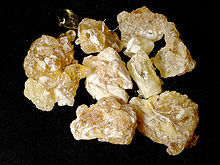
Frankincense
Animal sources
- Ambergris: Lumps of oxidized fatty compounds, whose precursors were secreted and expelled by the sperm whale. Ambergris should not be confused with yellow amber, which is used in jewellery. Because the harvesting of ambergris involves no harm to its animal source, it remains one of the few animalic fragrancing agents around which little controversy now exists.
- Castoreum: Obtained from the odorous sacs of the North American beaver.
- Civet: Also called Civet Musk, this is obtained from the odorous sacs of the civets, animals in the family Viverridae, related to the mongoose. World Animal Protection investigated African civets caught for this purpose.
- Hyraceum: Commonly known as "Africa Stone", is the petrified excrement of the Rock Hyrax.
- Honeycomb: From the honeycomb of the honeybee. Both beeswax and honey can be solvent extracted to produce an absolute. Beeswax is extracted with ethanol and the ethanol evaporated to produce beeswax absolute.
- Musk: Originally derived from a gland (sac or pod) located between the genitals and the umbilicus of the Himalayan male Musk deer Moschus moschiferus, it has now mainly been replaced by the use of synthetic musks sometimes known as "white musk".

A musk pod. Extensive hunting of male musk deer for their pods in recent history has resulted in the detriment of the species.
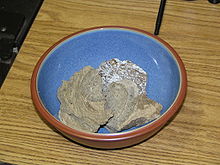
Ambergris
Other natural sources
- Lichens: Commonly used lichens include oakmoss and treemoss thalli.
- "Seaweed": Distillates are sometimes used as essential oil in perfumes. An example of a commonly used seaweed is Fucus vesiculosus, which is commonly referred to as bladder wrack. Natural seaweed fragrances are rarely used due to their higher cost and lower potency than synthetics.
SYNTHETIC SOURCES
Many modern perfumes contain synthesized odorants. Synthetics can provide fragrances which are not found in nature. For instance, Calone, a compound of synthetic origin, imparts a fresh ozonous metallic marine scent that is widely used in contemporary perfumes. Synthetic aromatics are often used as an alternate source of compounds that are not easily obtained from natural sources. For example, linalool and coumarin are both naturally occurring compounds that can be inexpensively synthesized from terpenes. Orchid scents (typically salicylates) are usually not obtained directly from the plant itself but are instead synthetically created to match the fragrant compounds found in various orchids.
One of the most commonly used classes of synthetic aromatics by far are the white musks. These materials are found in all forms of commercial perfumes as a neutral background to the middle notes. These musks are added in large quantities to laundry detergents in order to give washed clothes a lasting "clean" scent.
The majority of the world's synthetic aromatics are created by relatively few companies. They include:
- International Flavors and Fragrances (IFF)
- Givaudan
- Firmenich
- Takasago
- Symrise
Each of these companies patents several processes for the production of aromatic synthetics annually.
CHARACTERISTICS
Natural and synthetics are used for their different odour characteristics in perfumery
|
|
Naturals
|
Synthetics
|
|
Variance
|
Natural scents will vary from each supplier based on when and where they are harvested, how they are processed, and the extraction method itself. This means that a certain flower grown in Morocco and in France will smell different, even if the same method is used to grow, harvest, and extract the scent. As such, each perfumer will prefer flowers grown in one country over another, or one extraction method to the next. However, due to a natural scent's mixed composition, it is easy for unscrupulous suppliers to adulterate the actual raw materials by changing its source (adding Indian Jasmine into Grasse Jasmine) or the contents (adding linalool to Rosewood) to increase their profit margin.
|
Much more consistent than natural aromatics. However, differences in organic synthesis may result in minute differences in concentration of impurities. If these impurities have low smell (detection) thresholds, the differences in the scent of the synthetic aromatic will be significant.
|
|
Components
|
Contains many different organic compounds, each adding a different note to the overall scent. These naturally derived substances have a history of use, therefore it is easy to determine whether they are safe or not. Possible allergenic compounds.
|
Depending on purity, consists primarily of one chemical compound. Sometimes chiral mixtures of isomers, such as in the case of Iso E Super. Due to the almost pure composition of one chemical compound, the same molecules found diluted in nature will have a different scent and effect on the body, if used undiluted.
|
|
Scent Uniqueness
|
Reminiscent of its originating material, although extraction may capture a different "layer" of the scent, depending on the how the extraction method denatures the odoriferous compounds.
|
Similar to natural scents yet different at the same time. Some synthetics attempt to mimic natural notes, while others explore the entire spectrum of scent. Novel scent compounds not found in nature will often be unique in their scent.
|
|
Scent Complexity
|
Deep and complex fragrance notes. Soft, with subtle scent nuances. Highly valued for ideal composition.
|
Pure and pronounced fragrance notes. Often monotonous in nature, yet reminiscent of other natural scents.
|
|
Price
|
Dependent on extraction method. More expensive, but not always, as prices are determined by the labour and difficulty of properly extracting each unit of the natural materials, as well as its quality.
|
Dependent on synthesis method. Generally cheaper, but not necessarily. Synthetic aromatics are not necessarily cheaper than naturals, with some synthetics being more costly than most natural ingredients due to various factors such as the long synthesis routes, low availability of precursor chemicals, and low overall yield. However, due to their low odour threshold, they should be diluted when making a perfume.
|
OBTAINING NATURAL ODORANTS
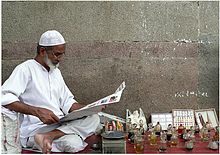
Itar (herbal perfume) vendor on the street of Hyderabad, India. The perfumers due to their fine sense of smell and skill in smell composition can compose an original perfume for the customer if asked.
Before perfumes can be composed, the odorants used in various perfume compositions must first be obtained. Synthetic odorants are produced through organic synthesis and purified. Odorants from natural sources require the use of various methods to extract the aromatics from the raw materials. The results of the extraction are either essential oils, absolutes, concretes, or butters, depending on the amount of waxes in the extracted product.
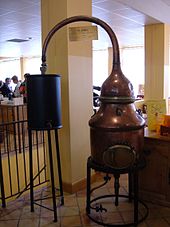
An old perfume still on display at Fragonard
All these techniques will, to a certain extent, distort the odour of the aromatic compounds obtained from the raw materials. This is due to the use of heat, harsh solvents, or through exposure to oxygen in the extraction process which will denature the aromatic compounds, which either change their odour character or renders them odourless.
- Maceration/Solvent extraction: The most used and economically important technique for extracting aromatics in the modern perfume industry. Raw materials are submerged in a solvent that can dissolve the desired aromatic compounds. Maceration lasts anywhere from hours to months. Fragrant compounds for woody and fibrous plant materials are often obtained in this manner as are all aromatics from animal sources. The technique can also be used to extract odorants that are too volatile for distillation or easily denatured by heat. Commonly used solvents for maceration/solvent extraction include hexane, and dimethyl ether. The product of this process is called a "concrete."
- Supercritical fluid extraction: A relatively new technique for extracting fragrant compounds from a raw material, which often employs Supercritical CO2. Due to the low heat of process and the relatively nonreactive solvent used in the extraction, the fragrant compounds derived often closely resemble the original odour of the raw material.
- Ethanol extraction: A type of solvent extraction used to extract fragrant compounds directly from dry raw materials, as well as the impure oily compounds materials resulting from solvent extraction or enfleurage. Ethanol extraction is not used to extract fragrance from fresh plant materials since these contain large quantities of water, which will also be extracted into the ethanol.
- Distillation: A common technique for obtaining aromatic compounds from plants, such as orange blossoms and roses. The raw material is heated and the fragrant compounds are re-collected through condensation of the distilled vapour.
- Steam distillation: Steam from boiling water is passed through the raw material, which drives out their volatile fragrant compounds. The condensates from distillation are settled in a Florentine flask. This allows for the easy separation of the fragrant oils from the water. The water collected from the condensate, which retains some of the fragrant compounds and oils from the raw material is called hydrosol and sometimes sold. This is most commonly used for fresh plant materials such as flowers, leaves, and stems.
- Dry/destructive distillation: The raw materials are directly heated in a still without a carrier solvent such as water. Fragrant compounds that are released from the raw material by the high heat often undergo anhydrous pyrolysis, which results in the formation of different fragrant compounds, and thus different fragrant notes. This method is used to obtain fragrant compounds from fossil amber and fragrant woods where an intentional "burned" or "toasted" odour is desired.
- Fractionation: Through the use of a fractionation column, different fractions distilled from a material can be selectively excluded to modify the scent of the final product. Although the product is more expensive, this is sometimes performed to remove unpleasant or undesirable scents of a material and affords the perfumer more control over their composition process.
- Expression: Raw material is squeezed or compressed and the oils are collected. Of all raw materials, only the fragrant oils from the peels of fruits in the citrus family are extracted in this manner since the oil is present in large enough quantities as to make this extraction method economically feasible.
- Enfleurage: Absorption of aroma materials into solid fat or wax and then extraction of odorous oils with ethyl alcohol. Extraction by enfleurage was commonly used when distillation was not possible because some fragrant compounds denature through high heat. This technique is not commonly used in the modern industry due to prohibitive costs and the existence of more efficient and effective extraction methods.
FRAGRANT EXTRACTS
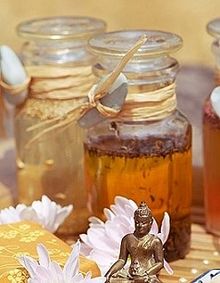
Essential oil
Although fragrant extracts are known to the general public as the generic term "essential oils", a more specific language is used in the fragrance industry to describe the source, purity, and technique used to obtain a particular fragrant extract. File:Diva (Ungaro).jpeg Of these extracts, only absolutes, essential oils, and tinctures are directly used to formulate perfumes.
- Absolute: Fragrant materials that are purified from a pomade or concrete by soaking them in ethanol. By using a slightly hydrophilic compound such as ethanol, most of the fragrant compounds from the waxy source materials can be extracted without dissolving any of the fragrantless waxy molecules. Absolutes are usually found in the form of an oily liquid.
- Concrete: Fragrant materials that have been extracted from raw materials through solvent extraction using volatile hydrocarbons. Concretes usually contain a large amount of wax due to the ease in which the solvents dissolve various hydrophobic compounds. As such concretes are usually further purified through distillation or ethanol based solvent extraction. Concretes are typically either waxy or resinous solids or thick oily liquids.
- Essential oil: Fragrant materials that have been extracted from a source material directly through distillation or expression and obtained in the form of an oily liquid. Oils extracted through expression are sometimes called expression oils.
- Pomade: A fragrant mass of solid fat created from the enfleurage process, in which odorous compounds in raw materials are adsorbed into animal fats. Pomades are found in the form of an oily and sticky solid.
- Tincture: Fragrant materials produced by directly soaking and infusing raw materials in ethanol. Tinctures are typically thin liquids.
Products from different extraction methods are known under different names even though their starting materials are the same. For instance, orange blossoms from Citrus aurantium that have undergone solvent extraction produces "orange blossom absolute" but that which have been steam distilled is known as "neroli oil".
COMPOSING PERFUMES
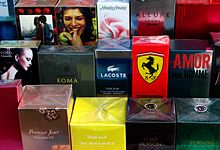
Counterfeit perfumes
Perfume compositions are an important part of many industries ranging from the luxury goods sectors, food services industries, to manufacturers of various household chemicals. The purpose of using perfume or fragrance compositions in these industries is to affect customers through their sense of smell and entice them into purchasing the perfume or perfumed product. As such there is significant interest in producing a perfume formulation that people will find aesthetically pleasing.
The perfumer

The Perfume Maker, by Rodolphe Ernst
The job of composing perfumes that will be sold is left up to an expert on perfume composition or known in the fragrance industry as the perfumer. They are also sometimes referred to affectionately as a "Nez" (French for nose) due to their fine sense of smell and skill in smell composition.
The composition of a perfume typically begins with a brief by the perfumer's employer or an outside customer. The customers to the perfumer or their employers, are typically fashion houses or large corporations of various industries. The perfumer will then go through the process of blending multiple perfume mixtures and sell the formulation to the customer, often with modifications of the composition of the perfume.
The perfume composition will then be either used to enhance another product as a functional fragrance (shampoos, make-up, detergents, car interiors, etc.), or marketed and sold directly to the public as a fine fragrance.
Technique
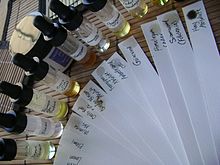 A
A
Paper blotters (fr:mouillettes) are commonly used by perfumers to sample and smell perfumes and odorants.
Although there is no single "correct" technique for the formulation of a perfume, there are general guidelines as to how a perfume can be constructed from a concept. Although many ingredients do not contribute to the smell of a perfume, many perfumes include colorants and anti-oxidants to improve the marketability and shelf life of the perfume, respectively.
Basic framework
Perfume oils usually contain tens to hundreds of ingredients and these are typically organized in a perfume for the specific role they will play. These ingredients can be roughly grouped into four groups:
- Primary scents (Heart): Can consist of one or a few main ingredients for a certain concept, such as "rose". Alternatively, multiple ingredients can be used together to create an "abstract" primary scent that does not bear a resemblance to a natural ingredient. For instance, jasmine and rose scents are commonly blends for abstract floral fragrances. Cola flavourant is a good example of an abstract primary scent.
- Modifiers: These ingredients alter the primary scent to give the perfume a certain desired character: for instance, fruit esters may be included in a floral primary to create a fruity floral; calone and citrus scents can be added to create a "fresher" floral. The cherry scent in cherry cola can be considered a modifier.
- Blenders: A large group of ingredients that smooth out the transitions of a perfume between different "layers" or bases. These themselves can be used as a major component of the primary scent. Common blending ingredients include linalool and hydroxycitronellal.
- Fixatives: Used to support the primary scent by bolstering it. Many resins, wood scents, and amber bases are used as fixatives.
The top, middle, and base notes of a fragrance may have separate primary scents and supporting ingredients. The perfume's fragrance oils are then blended with ethyl alcohol and water, aged in tanks for several weeks and filtered through processing equipment to, respectively allow the perfume ingredients in the mixture to stabilize and to remove any sediment and particles before the solution can be filled into the perfume bottles.
Fragrance bases
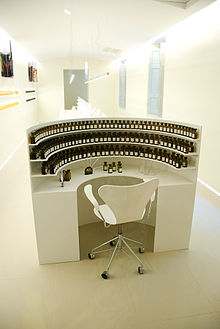
A "perfume organ", where perfumers play around with hundreds of essences, in Grasse
Instead of building a perfume from "ground up", many modern perfumes and colognes are made using fragrance bases or simply bases. Each base is essentially modular perfume that is blended from essential oils and aromatic chemicals, and formulated with a simple concept such as "fresh cut grass" or "juicy sour apple". Many of Guerlain's Aqua Allegoria line, with their simple fragrance concepts, are good examples of what perfume fragrance bases are like.
The effort used in developing bases by fragrance companies or individual perfumers may equal that of a marketed perfume, since they are useful in that they are reusable. On top of its reusability, the benefit in using bases for construction are quite numerous:
- Ingredients with "difficult" or "overpowering" scents that are tailored into a blended base may be more easily incorporated into a work of perfume
- A base may be better scent approximations of a certain thing than the extract of the thing itself. For example, a base made to embody the scent for "fresh dewy rose" might be a better approximation for the scent concept of a rose after rain than plain rose oil. Flowers whose scents cannot be extracted, such as gardenia or hyacinth, are composed as bases from data derived from headspace technology.
- A perfumer can quickly rough out a concept from a brief by combining multiple bases, then present it feedback. Smoothing out the "edges" of the perfume can be done after a positive response.
Reverse engineering
Creating perfumes through reverse engineering with analytical techniques such as Gas chromatography–mass spectrometry (GC/MS) can reveal the "general" formula for any particular perfume. The difficulty of GC/MS analysis arises due to the complexity of a perfume's ingredients. This is particularly due to the presence of natural essential oils and other ingredients consisting of complex chemical mixtures. However, "anyone armed with good GC/MS equipment and experienced in using this equipment can today, within days, find out a great deal about the formulation of any perfume... customers and competitors can analyze most perfumes more or less precisely."
Antique or badly preserved perfumes undergoing this analysis can also be difficult due to the numerous degradation by-products and impurities that may have resulted from breakdown of the odorous compounds. Ingredients and compounds can usually be ruled out or identified using gas chromatograph (GC) smellers, which allow individual chemical components to be identified both through their physical properties and their scent. Reverse engineering of best-selling perfumes in the market is a very common practice in the fragrance industry due to the relative simplicity of operating GC equipment, the pressure to produce marketable fragrances, and the highly lucrative nature of the perfume market.
Copyright

Angel for men (A*Men) by Thierry Mugler
It is doubtful whether perfumes qualify as appropriate copyright subject matter under the US Copyright Act. The issue has not yet been addressed by any US court. A perfume's scent is not eligible for trademark protection because the scent serves as the functional purpose of the product.
In 2006 the Dutch Supreme Court granted copyright protection to Lancome's perfume Tresor (Lancome v. Kecofa). The French Supreme Court has twice taken the position that perfumes lack the creativity to constitute copyrightable expressions (Bsiri-Barbir v. Haarman & Reimer, 2006; Beaute Prestige International v. Senteur Mazal, 2008).
HEALTH AND ENVIRONMENTAL ISSUES
Perfume ingredients, regardless of natural or synthetic origins, may all cause health or environmental problems when used or abused in substantial quantities. Although the areas are under active research, much remains to be learned about the effects of fragrance on human health and the environment.
Health
Immunological; asthma and allergy
Evidence in peer-reviewed journals shows that some fragrances can cause asthmatic reactions in some individuals, especially those with severe or atopic asthma. Many fragrance ingredients can also cause headaches, allergic skin reactions or nausea.
In some cases, an excessive use of perfumes may cause allergic reactions of the skin. For instance, acetophenone, ethyl acetate and acetone while present in many perfumes, are also known or potential respiratory allergens. Nevertheless this may be misleading, since the harm presented by many of these chemicals (either natural or synthetic) is dependent on environmental conditions and their concentrations in a perfume. For instance, linalool, which is listed as an irritant, causes skin irritation when it degrades to peroxides, however the use of antioxidants in perfumes or reduction in concentrations can prevent this. As well, the furanocoumarin present in natural extracts of grapefruit or celery can cause severe allergic reactions and increase sensitivity to ultraviolet radiation.
Some research on natural aromatics have shown that many contain compounds that cause skin irritation. However some studies, such as IFRA's research claim that opoponax is too dangerous to be used in perfumery, still lack scientific consensus. It is also true that sometimes inhalation alone can cause skin irritation.

Patch test
A number of national and international surveys have identified Balsam of Peru, often used in perfumes, as being in the "top five" allergens most commonly causing patch test reactions in people referred to dermatology clinics. A study in 2001 found that 3.8% of the general population patch tested was allergic to it. Many perfumes contain components identical to Balsam of Peru.
Before 1977, the main recommended marker for perfume allergy was Balsam of Peru, which is still advised. The presence of Balsam of Peru in a cosmetic will be denoted by the INCI term Myroxylon pereirae. Because of allergic reactions, since 1982 crude Balsam of Peru has been banned by the International Fragrance Association from use as a fragrance compound, but extracts and distillates are used up to a maximum level of 0.4% in products, and are not covered by mandatory labelling.
Carcinogenicity
There is scientific evidence that nitro-musks such as musk xylene could cause cancer in some specific animal tests. These reports were evaluated by the EU Scientific Committee for Consumer Safety (SCCS, formerly the SCCNFP) and Musk Xylene was found to be safe for continued use in cosmetic products. It is in fact part of the procedures of the Cosmetic Regulation in Europe that materials classified as carcinogens require such a safety evaluation by the authorities to be allowed in cosmetic consumer products.
Although other ingredients such as polycyclic synthetic musks, have been reported to be positive in some in-vitro hormone assays, these reports have been reviewed by various authorities. For example for one of the main polycyclic musks Galaxolide (HHCB) these reviews includes those of the EU Scientific Committee on Consumer Safety, the EU's Priority Substances Review, the EU Scientific Committee on Health and Environmental Risk and more recently also the US EPA. The outcome of all of these reviews over the past decade or so is that there is no safety concerns for human health. Reviews with similar positive outcome exists for another main polycyclic musk (AHTN) as well for instance on its safe us in cosmetics by the EU.
Many natural aromatics, such as oakmoss absolutes, basil oil, Rose oil and many others contain allergens or carcinogenic compounds, the safety of which is either governed by regulations (e.g. allowed methyl eugenol levels in the EU Cosmetics Regulation (Entry 102, Annex III of the EU Cosmetics Regulation) or through various limitations set by the International Fragrance Association.
Toxicity
Certain chemicals found in perfume are often toxic, at least for small insects if not for humans. For example the compound Tricyclodecenyl allyl ether is often found in synthetic perfumes and has insect repellent property.
Environmental

Perfume stall in Cairo
Pollution
Synthetic musks are pleasant in smell and relatively inexpensive, as such they are often employed in large quantities to cover the unpleasant scent of laundry detergents and many personal cleaning products. Due to their large-scale use, several types of synthetic musks have been found in human fat and milk, as well as in the sediments and waters of the Great Lakes.
These pollutants may pose additional health and environmental problems when they enter human and animal diets.
Species endangerment
The demands for aromatic materials such as sandalwood, agarwood, and musk has led to the endangerment of these species, as well as illegal trafficking and harvesting.
Safety regulation
The perfume industry in the US is not directly regulated by the FDA, instead the FDA controls the safety of perfumes through their ingredients and requires that they be tested to the extent that they are Generally recognized as safe (GRAS). Due to the need for protection of trade secrets, companies rarely give the full listing of ingredients regardless of their effects on health. In Europe, as from 11 March 2005, the mandatory listing of a set of 26 recognized fragrance allergens was enforced. The requirement to list these materials is dependent on the intended use of the final product. The limits above which the allergens are required to be declared are 0.001% for products intended to remain on the skin, and 0.01% for those intended to be rinsed off. This has resulted in many old perfumes like chypres and fougère classes, which require the use of oakmoss extract, being reformulated.
PRESERVING PERFUME
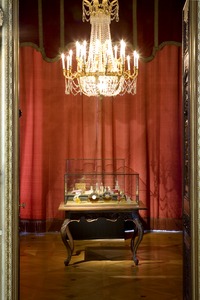
Perfumes in museum
Fragrance compounds in perfumes will degrade or break down if improperly stored in the presence of:
- Heat
- Light
- Oxygen
- Extraneous organic materials
Proper preservation of perfumes involves keeping them away from sources of heat and storing them where they will not be exposed to light. An opened bottle will keep its aroma intact for several years, as long as it is well stored. However the presence of oxygen in the head space of the bottle and environmental factors will in the long run alter the smell of the fragrance.
Perfumes are best preserved when kept in light-tight aluminium bottles or in their original packaging when not in use, and refrigerated to relatively low temperatures: between 3–7 °C (37–45 °F). Although it is difficult to completely remove oxygen from the headspace of a stored flask of fragrance, opting for spray dispensers instead of rollers and "open" bottles will minimize oxygen exposure. Sprays also have the advantage of isolating fragrance inside a bottle and preventing it from mixing with dust, skin, and detritus, which would degrade and alter the quality of a perfume.
There exist several archives and museums devoted to the preservation of historical perfumes, namely the Osmothèque, which stocks over 3,000 perfumes from the past two millennia in their original formulations. All scents in their collection are preserved in non-actinic glass flasks flushed with argon gas, stored in thermally insulated compartments maintained at 12 °C (53.6 °F) in a large vault.

Potpourri, by Edwin Austin Abbey, 1899
Click here for a list of perfumes
Click here for a list of celebrity branded fragrances
For more information re perfumes, please click on the following link: http://en.wikipedia.org/wiki/Perfume
